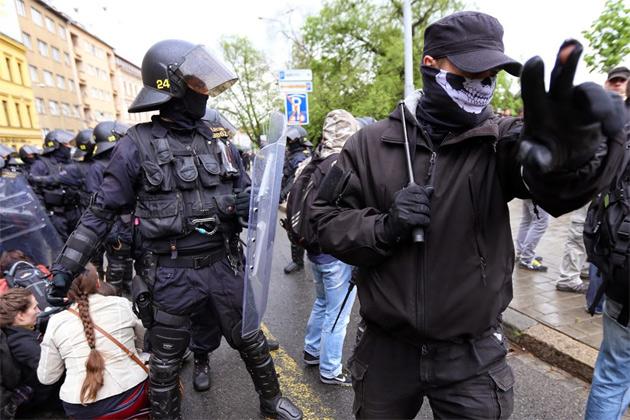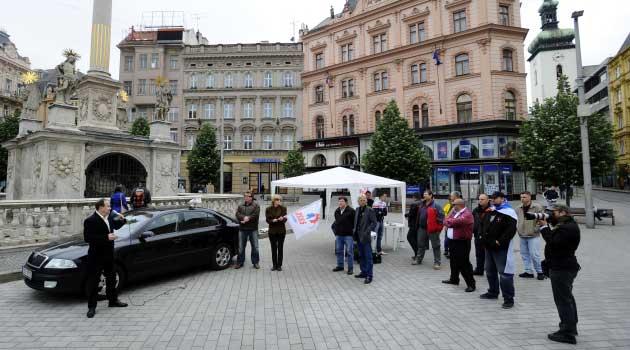Every other year, the city of Brno becomes a place where right-wing radicals from all over the Czech Republic gather for a 1 May demonstration. In previous years, every such assembly, irrespective of its size, has produced a completely different outcome.
All of these neo-Nazi marches have sparked reactions and counter-protesters have taken to the streets in response, whether in their hundreds (as in 2002) or just a few dozen (as in 2005). In 2002, the 1 May event ended with a rapid police intervention against the anarchist counter-demonstration.
As the anarchists, surrounded by police on that occasion, were being beaten with truncheons, the neo-Nazis triumphantly marched through the city. A similar scenario was repeated this year.
The only difference between 2015 and 2002, is that 13 years ago the antifascists were morally prepared for a violent confrontation and were armed for one. In contrast, the demonstrators who turned out this year and who are now being called "the blockaders" came to the event without arms or protective equipment, carrying flowers and smiles, and they definitely did not anticipate ending up bruised in a police van.
Will Vandas end up in court for hate speech?
The atmospheres of the different assemblies in Brno on 1 May this year sharply contrasted with one another. While the relaxed event in front of the Mahenovo Theater was reminiscent of a summer festival – children, the celebration of mass, music – things were not happy on the square where the neo-Nazis gathered.
Erik Lamprecht, the nervous convener of that event, surveyed the square in disbelief – even with dozens of journalists, passers-by and plainclothes police, it definitely did not look full. His international guests, Matteo Caponetti of the Italian organization Zenit and Pierre Dornbrach of the German organization Junge Nationaldemokraten, did not make it.
There was, therefore, no choice but for the stammering representatives of the Workers’ Youth organization to read their speeches on their own. The main star was DSSS chair Tomáš Vandas, who knows how to speak extemporaneously but lacks charisma and has been repeating the same old phrases for several years now.
This time Vandas wanted his speech to be more captivating, so he took a series of hateful swipes at immigrants. It is very likely that this will result once more in a skirmish in the courts, just like last time when he was ultimately given a suspended sentence for a speech he gave at that very same spot.
PHOTO GALLERY
Workers’ Youth procession blocked, police intervene
After the speeches, the supporters of the Workers’ Youth (and the DSSS) lined up in a sort of moving wall that headed toward the train station. The blockaders, in the meantime, had moved into the streets surrounding Malinovského Square where they began an actual blockade, because the fans of Vandas were slated to proceed through that square.
Lamprecht spent most of his time on the way there arguing with Czech Police Colonel Janík, who, with the input of the police’s Anti-Conflict Team, offered him an alternative route. The neo-Nazis would be able to avoid the blockaded square by taking up this offer.
After a lengthy, nervous negotiation, during which Vandas seized the opportunity to shout to the television cameras that the police should disperse the blockade with tear gas, the procession moved toward Koliště Street. That empty urban thoroughfare became the first place where the right-wing radicals passed by the antifascists in close proximity.
The antifascists whistled at the neo-Nazis from behind a barricade formed by mounted officers and police minivans. Several relatively harmless objects also flew threw the air, such as fruit or plastic bottles.
At that moment the police Special Riot Unit (Speciální pořádková jednotka – SPJ) did not succeed in sealing off the nearby park, and about 100 blockaders ran into it. Another several hundred slowly moved to the mouth of Lidická Street behind the police barricade.
The antifascists in the park ran out onto the empty road within seconds and sat on the ground. The neo-Nazis were forced to stop once more.
A round of negotiations took place and then the SPJ threatened to intervene, which they ultimately did. A small group of plainclothes detectives wielding collapsible truncheons and wearing masks joined the uniformed officers in that effort.
The protesters passively sat on the ground and waited "their turn". Almost none of them resisted.
Another blockade, a harsher riot police intervention
After the blockaders were arrested, the Workers’ Youth procession moved forward another couple of meters and even more demanding negotiations began. Roughly 500 blockaders had managed to pack themselves in behind the police vans and the SPJ cordon, determined not to retreat.
After half an hour, the police decided to forcefully intervene, pushing the crowd into Lidická Street. The first three rows of counter-protesters were struck with collapsible truncheons and tonfas.
The mounted officers and the SPJ also used a new weapon against the crowd this time, a powerfull paintball rifle aimed at people’s feet. This gave rise to a rumor that rubber bullets were being used.
Several individuals were also given doses of hand-held tear gas by the officers. The neo-Nazi procession immediately entered the space that had been cleared and continued on under police protection.
When the march arrived at Svoboda Square, several dozen blockaders await them. Their ranks include Czech Senator Zdeněk Papoušek and former Czech Education Minister Ondřej Liška.
The police quickly cleared this small group without making any arrests. The Workers’ Youth members then rapidly packed up their sound equipment and their tent and dispersed in small groups down Masaryk Street, where they were to attend a concert that evening in the Brooklyn club – but the concert was a fiasco, because none of the advertised bands ultimately showed up.
Who won?
Depending on your perspective, 1 May in Brno this year was a victory for all involved. The neo-Nazis actually did march through the city, but their numbers were pitifully small, they had to constantly stop at every blockade, and the entire event was pretty much botched organizationally (to say nothing of the anticipated repression that may yet await Vandas for his speech).
The blockaders did actually blockade the route and mobilized even some whose views might not be so clear-cut to join their side. They also won a great deal of support, both from the media and morally.
After many years, the media have finally managed to break with their traditional reporting on such events as if they were a "sports match" between two equivalent teams. However, there were many people at the blockade who had no experience with such events and who were subsequently quite amazed – even shocked – by the police intervention, which objectively speaking was mild overall.
The police kept both camps of demonstrators away from each other, unlike 17 November of last year, when, because of a police error, the antifascists made it into the crowd of neo-Nazis and a minor brawl ensued. On 1 May nothing was left to chance.
The intervening SPJ has become the target of criticism, but police commanders (unfortunately) follow the law, not moral principles. According to the law, the blockade of Koliště Street was illegal, so the police intervened.
Those participating in the blockade were aware of this. They were not afraid to stand up for their beliefs despite the risk of arrest or a beating.

